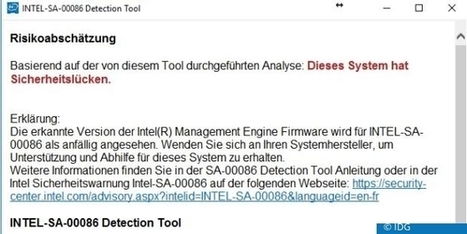Über eine Lücke in Intel AMT können Angreifer sich binnen Sekunden den Zugriff auf Laptops verschaffen. So schützen Sie sich.
Die Sicherheitsexperten von F-Secure warnen vor einer Lücke in Intel AMT, die es Angreifern erlaubt, binnen weniger Sekunden die Kontrolle über Notebooks zu übernehmen. Schuld daran sind unsichere Standardeinstellungen in Intel AMT, durch die Angreifer das Nutzer- und BIOS-Passwort und den Bitlocker- und TMP-Schutz umgehen können, um Hintertüren auf den Geräten zu installieren.
Betroffen sind Firmen-Notebooks, in denen Intels Active Management Technology (ATM) zum Einsatz kommt, wodurch die Geräte von IT-Abteilungen verwaltet und aus der Ferne gewartet werden können. Intel AMT stand schon öfters wegen Sicherheitsproblemen in der Kritik. Bei der neuesten Schwachstelle bezeichnet F-Secure Angriffe als „fast schon lächerlich einfach“.
Learn more / En savoir plus / Mehr erfahren:
https://www.scoop.it/t/securite-pc-et-internet/?&tag=intel



 Your new post is loading...
Your new post is loading...














Über eine Lücke in Intel AMT können Angreifer sich binnen Sekunden den Zugriff auf Laptops verschaffen. So schützen Sie sich.
Die Sicherheitsexperten von F-Secure warnen vor einer Lücke in Intel AMT, die es Angreifern erlaubt, binnen weniger Sekunden die Kontrolle über Notebooks zu übernehmen. Schuld daran sind unsichere Standardeinstellungen in Intel AMT, durch die Angreifer das Nutzer- und BIOS-Passwort und den Bitlocker- und TMP-Schutz umgehen können, um Hintertüren auf den Geräten zu installieren.
Betroffen sind Firmen-Notebooks, in denen Intels Active Management Technology (ATM) zum Einsatz kommt, wodurch die Geräte von IT-Abteilungen verwaltet und aus der Ferne gewartet werden können. Intel AMT stand schon öfters wegen Sicherheitsproblemen in der Kritik. Bei der neuesten Schwachstelle bezeichnet F-Secure Angriffe als „fast schon lächerlich einfach“.
Learn more / En savoir plus / Mehr erfahren:
https://www.scoop.it/t/securite-pc-et-internet/?&tag=intel